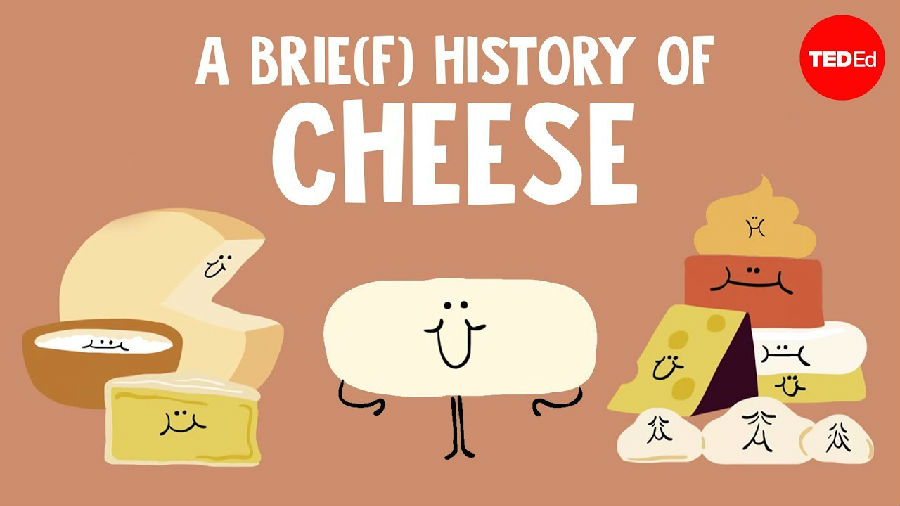Before empires and royalty, before pottery and writing, before metal tools and weapons -- there was cheese.
在王国与皇室存在之前,在陶器与文字存在之前,在金属工具与武器存在之前,奶酪就已经存在了。
As early as 8000 BCE, the earliest Neolithic farmers living in the Fertile Crescent began a legacy of cheesemaking almost as old as civilization itself.
早在公元前8000年,新石器时代早期,居住在新月沃土的农民就开始了奶酪制造的传承,几乎和文明一样久远。
The rise of agriculture led to domesticated sheep and goats, which ancient farmers harvested for milk.
农业的崛起使农民们开始圈养绵羊和山羊,以获取羊乳。
But when left in warm conditions for several hours, that fresh milk began to sour.
当他们把羊乳放在高温的环境数小时后,新鲜羊乳开始发酸。
Its lactic acids caused proteins to coagulate, binding into soft clumps.
这是因为羊乳里的乳酸使蛋白质凝结,变成柔软的半固体结块。
Upon discovering this strange transformation, the farmers drained the remaining liquid -- later named whey
当发现这个奇怪的现象后,农民们把剩余的液体倒掉--后称乳清,
and found the yellowish globs could be eaten fresh as a soft, spreadable meal.
然后发现这些柔软,可涂开的黄色结块可以新鲜食用。
These clumps, or curds, became the building blocks of cheese,
这些结块,或称凝乳,能用来做奶酪,
which would eventually be aged, pressed, ripened, and whizzed into a diverse cornucopia of dairy delights.
而奶酪经过陈化、压榨、成熟和搅拌等加工处理后,便能制成各种各样的乳制品。
The discovery of cheese gave Neolithic people an enormous survival advantage.
奶酪的发现给了新石器时代人类巨大的生存优势。
Milk was rich with essential proteins, fats, and minerals.
奶中含有丰富的蛋白质、脂肪与矿物质。
But it also contained high quantities of lactose -- a sugar which is difficult to process for many ancient and modern stomachs.
但同时也含有大量的乳糖--而乳糖不耐症是过去到现代很多人的通病。
Cheese, however, could provide all of milk's advantages with much less lactose.
然而,奶酪不但能提供所有奶中含有的营养,且乳糖含量较低。
And since it could be preserved and stockpiled, these essential nutrients could be eaten throughout scarce famines and long winters.
由于奶酪可以长期储存,这些营养可以随时被食用,无论是在饥荒时期或是寒冬。
Some 7th millennium BCE pottery fragments found in Turkey still contain telltale residues of the cheese and butter they held.
在土耳其出土的前7千纪时期的陶器碎片上,仍含有奶酪和黄油的残留物。
By the end of the Bronze Age, cheese was a standard commodity in maritime trade throughout the eastern Mediterranean.
在青铜时代末期,奶酪已是整个地中海东部地区港口贸易的常见货物。
In the densely populated city-states of Mesopotamia, cheese became a staple of culinary and religious life.
在人口密集的美索不达米亚城市,奶酪是人们的料理和宗教生活中很重要的一部分。
Some of the earliest known writing includes administrative records of cheese quotas,
已知最古老的文献当中包含奶酪配额的行政记录,
listing a variety of cheeses for different rituals and populations across Mesopotamia.
详细记载了美索不达米亚地区不同人群和祭典的奶酪配额。
Records from nearby civilizations in Turkey also reference rennet.
附近土耳其文明的记录中也提到凝乳酶。
This animal byproduct, produced in the stomachs of certain mammals, can accelerate and control coagulation.
这是某些哺乳动物胃中生产的一种酶,可用来加速和控制乳汁内蛋白质的凝结。

Eventually this sophisticated cheesemaking tool spread around the globe, giving way to a wide variety of new, harder cheeses.
最终,这种先进的奶酪制造技术传遍全球,推进了各种全新的,更硬的奶酪的发明。
And though some conservative food cultures rejected the dairy delicacy, many more embraced cheese, and quickly added their own local flavors.
虽然一些比较保守的饮食文化拒绝了这种美味的乳制品,但更多接受了奶酪,并添加了他们本土的风味。
Nomadic Mongolians used yaks' milk to create hard, sundried wedges of Byaslag.
蒙古的游牧民族用牦牛的奶,晒干变硬后制成蒙古奶酪。
Egyptians enjoyed goats' milk cottage cheese, straining the whey with reed mats.
埃及人喜欢吃山羊奶制成的白软干酪,利用芦苇制成的奶酪席来排除乳清。
In South Asia, milk was coagulated with a variety of food acids, such as lemon juice, vinegar, or yogurt and then hung to dry into loafs of paneer.
南亚地区的居民使用多种酸性食品来促进乳汁的凝结,其中包括柠檬汁、醋或酸奶,随后挂起来风干制成印度奶酪。
This soft mild cheese could be added to curries and sauces, or simply fried as a quick vegetarian dish.
这种奶酪较松软且味道较淡,因此能加到咖喱和调料当中,或者直接煎制,做成一道快速的素食料理。
The Greeks produced bricks of salty brined feta cheese, alongside a harder variety similar to today's pecorino romano.
希腊人把砖块状的奶酪浸泡在盐水里制成菲达奶酪和其他更坚硬的种类,类似于现今的罗马诺奶酪。
This grating cheese was produced in Sicily and used in dishes all across the Mediterranean.
这种能刨成丝的奶酪生产于西西里岛,整个地中海地区都会用到它来制做料理。
Under Roman rule, "dry cheese" or "caseus aridus," became an essential ration for the nearly 500,000 soldiers guarding the vast borders of the Roman Empire.
在罗马的统治下,干奶酪是一种非常重要的军需,供给约50万名守卫着罗马帝国边界的军人。
And when the Western Roman Empire collapsed, cheesemaking continued to evolve in the manors that dotted the medieval European countryside.
而在西罗马帝国消亡时的中世纪时期,奶酪的制造技术仍然在欧洲郊区各地散布的庄园中持续的进化。
In the hundreds of Benedictine monasteries scattered across Europe,
在遍布欧洲的几百个本笃会修道院中,
medieval monks experimented endlessly with different types of milk, cheesemaking practices,
僧侣们没日没夜的研究着不同种类的乳汁,奶酪制造方法
and aging processes that led to many of today's popular cheeses.
和陈化奶酪的过程,研发出了现今非常受欢迎的多种奶酪。
Parmesan, Roquefort, Munster and several Swiss types were all refined and perfected by these cheesemaking clergymen.
帕尔玛奶酪、罗克福奶酪、芒斯特奶酪和几种瑞士的奶酪,都是因为这些牧师的研究而得到改良和完善。
In the Alps, Swiss cheesemaking was particularly successful -- producing a myriad of cow's milk cheeses.
在阿尔卑斯山脉,瑞士的奶酪制造尤其成功--研发了无数的牛乳奶酪。
By the end of the 14th century, Alpine cheese from the Gruyere region of Switzerland had become so profitable
在14世纪末,瑞士格鲁耶尔地区的高山奶酪变得非常赚钱,
that a neighboring state invaded the Gruyere highlands to take control of the growing cheese trade.
因此邻国的军队侵占了此地,以便控制迅速发展的奶酪贸易。
Cheese remained popular through the Renaissance, and the Industrial Revolution took production out of the monastery and into machinery.
在文艺复兴时期,奶酪依旧十分受欢迎,而工业革命把奶酪的制造移出了修道院,进入了工厂。
Today, the world produces roughly 22 billion kilograms of cheese a year, shipped and consumed around the globe.
现在,全世界一年共生产约220亿公斤的奶酪,出口至全球并被食用。
But 10,000 years after its invention, local farms are still following in the footsteps of their Neolithic ancestors,
但在奶酪被发明1万年后的今日,本地的农场依旧追随着新石器时代先祖们的脚步,
hand crafting one of humanity's oldest and favorite foods.
手工制造人类文明中最古老也最受欢迎的食物。


